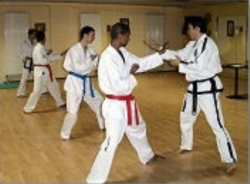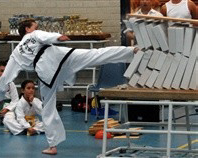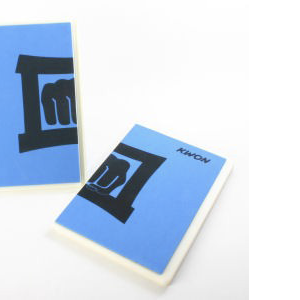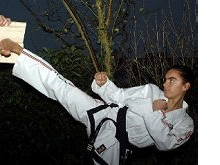Knowledge of Taekwondo for 5th KUP
Knowledge Knowledge of Taekwondo for 5th KUP K5
Matsugi
Reminder
Taekwondo students learn the techniques of Matsogi. Those are taught with the movements from the tuls to learn how to apply them in sparring.
There are three types of Matsogi: Sambo Matsogi (three step sparring), Ibo Matsogi (two-step sparring) and Il- bo Matsogi (one step sparring).
For the yellow belt exam, candidates must perform five three steps. This is done in pairs.
Methodology
You stand facing each other, bow to each other, then the attacker (pre-arranged) measures the distance needed to perform the attack. After that, the attacker goes backward with his right leg in gunnun sogi najunde bakat palmok makgi. This is the initial position in which each three-step is carried out.
In theory, the defender determines which attack will be performed, but for practical reasons (on the distance between the performers), we recommend that the attacker decides which attack he will be performing. After all, the defender knows beforehand what technique the attacker will use).
Once the attacker has called the technique, he states that he is ready to attack ("TSE"). The defender ponders what technique he will use to defend and indicates that he is ready ("TSE"). The defender may take his time to get prepared for.
Afterwards the attacker kicks or punches and the defender defends/blocks three times. The defender then performs a counterattack.
Then reverse roles. The attacker brings his front leg back to NARANI SOGI (ie backwards) and the defender brings his back leg forward to NARANI SOGI. Now it's up to the person who has just defended for to attack.
Attention to:
It is important to set the feet in the right place. In an attack in niunja sogi, the attacker's feet are placed on the outside of the feet of the defender. If an attack is in gunnun sogi the foot of the attacker is placed on the right side of the foot of the defender, so first on the outside and second time on the inside.
The defender performs a counterattack depending on the distance between the two people. If the distance is large then a kicking technique can be used; it is recommended to have a hand technique at a short distance.
For the exam
The student must perform 12 SAMBO MATSUGI program. In addition, the student must be able perform 5 IBO MATSUGI (two step sparring).
The difference with the three-step consists in the method of attack: in contrast to the three step sparring, where the attacker attacked three times with the same attack, the attack is two-step sparring is in two different attacks; a kick and a punch, or vice versa.
Similarly, the starting position, in which the attacker starts, is different from the SAMBO MATSUGI.
Instead of a GUNNUN SOGI PALMOK NAJUNDE MAKGI, the attacker begins in NIUNJA MAKGI PALMOK DAEBI MAKGI.
BREAK TECHNIQUES OR KYEK PA
Many think that the basic shape and size needed to break a board. But that is not so. There different things to look at. Here are the factors which lead to a higher degree of physical strength.
- Action-Reaction : Every force has an equal and opposite force. Therefore, in taekwondo with every move the hand quickly withdrawn to the hip.
- Concentration: The maximum power is only given at the time of impact.
- Balance: The body is balanced with each technique. This can be done by a proper position to take.
- Breathing: The control of breathing not only affects the speed and power. It can also prepare the body for a fight. Never breathe in the moment of the impact!
- Wave motion: Relationship strength - relaxation.
- Speed: Speed is the most essential factor when invoking force or pressure.
Scientifically, force equals mass times acceleration
Force = mass x speed
To know :
The bursting test must be passed with 1.5 to 3.5 cm wide pine plank of wood the size of 30x30 cm.
How to proceed?
- Come to the place, than greet.
- Measure the distance down to the shelf. Take a good distance, certainly not too short.
- Breathe in and out. Measure one more time the distance.
- Come in JUNBI.
- Break the shelf.
- Come back in JUNBI.
- Greet.
Note: Always be peaceful and calm. Remember, use your whole body. You break the board with your hips, shoulders. Get it off your power. Also remember that you not would, but should hit the shelf.



